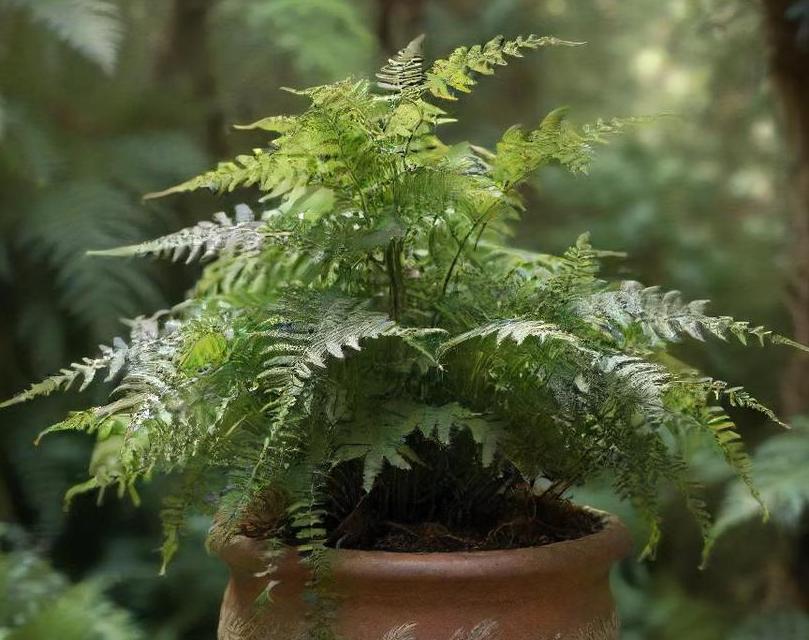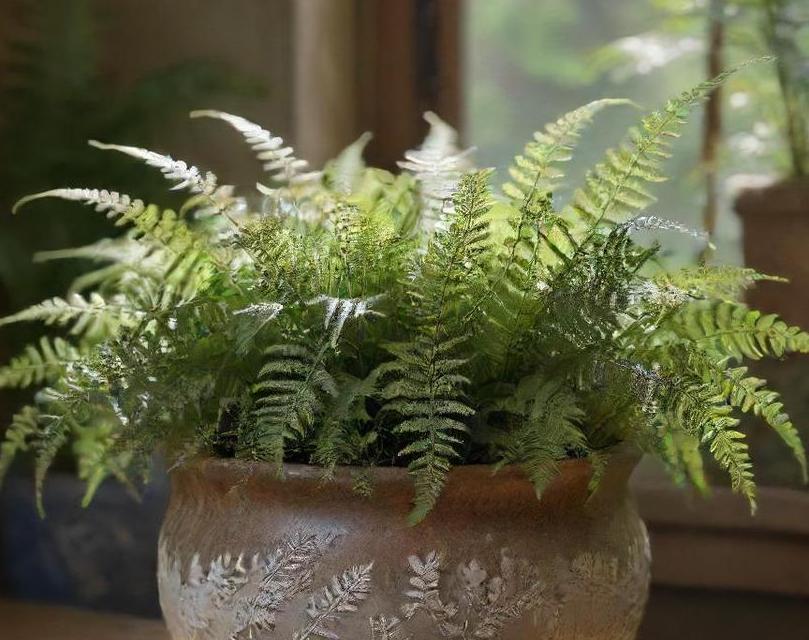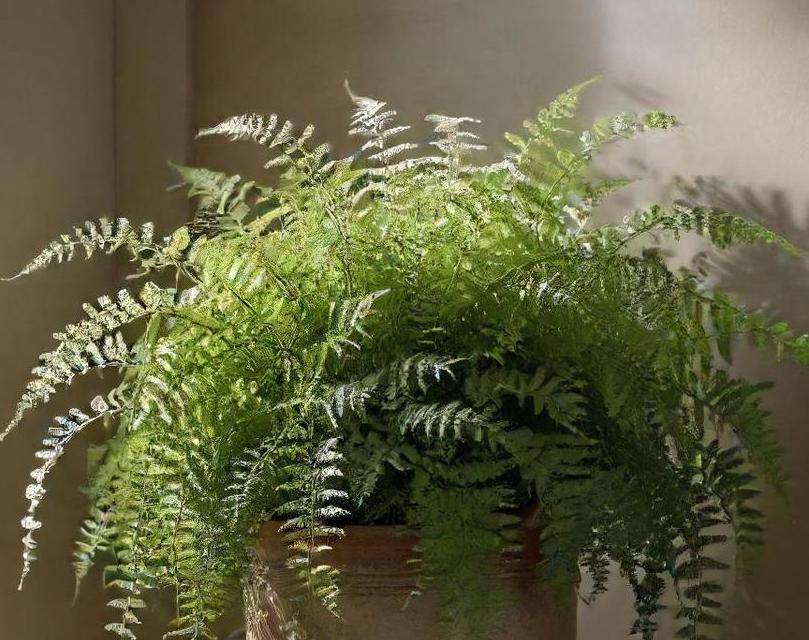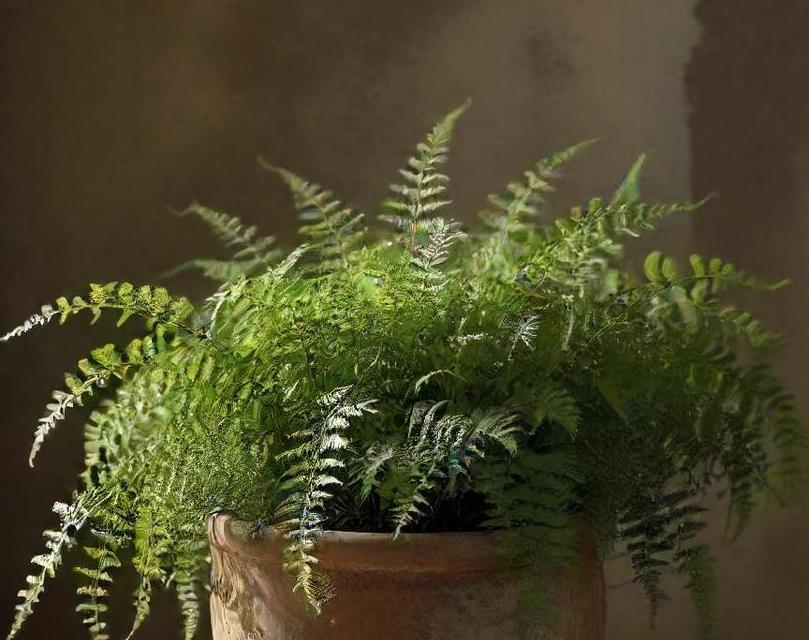- You are here:
- Home »
- Indoor Plants
- » Delta Maidenhair Fern Care Guide

Delta Maidenhair Fern Care Guide
Indoor plants not only beautify our living spaces but also provide numerous health benefits, from purifying the air to reducing stress levels. Among the plethora of options available, the Delta Maidenhair Fern stands out as a delicate and elegant choice for indoor gardening enthusiasts. This article delves into the intricacies of this captivating plant, exploring its botanical characteristics, historical and cultural significance, common names, and varieties.
Contents
- 1 What Is Delta Maidenhair Fern?
- 2 Botanical Characteristics
- 3 Historical And Cultural Significance
- 4 Common Names And Varieties
- 5 Light Requirements
- 6 Soil Requirements
- 7 Temperature Requirements
- 8 Humidity Requirements
- 9 Watering Needs For Delta Maidenhair Fern
- 10 Fertilization
- 11 How To Plant Delta Maidenhair Fern
- 12 Potting
- 13 Pruning Techniques For Delta Maidenhair Fern
- 14 Propagation Methods For Delta Maidenhair Fern
- 15 Troubleshooting Problems With Planting Delta Maidenhair Fern Indoors
- 16 Conclusion
- 17 FAQS
What Is Delta Maidenhair Fern?
The Delta Maidenhair Fern, scientifically known as Adiantum raddianum, is a species of fern in the Pteridaceae family. Originating from the tropical regions of South America, particularly Brazil, it has garnered popularity worldwide as an ornamental houseplant.
Characterized by its gracefully arching fronds and distinctive foliage, the Delta Maidenhair Fern adds a touch of sophistication to any indoor setting. Its delicate appearance belies its resilience, making it a favored choice for both novice and experienced plant enthusiasts alike.
Botanical Characteristics
Fronds
The most striking feature of the Delta Maidenhair Fern is its fronds, which are comprised of numerous small leaflets arranged along wiry black stems. These leaflets are fan-shaped and have a lacy appearance, giving the plant an airy and ethereal quality. Each frond can reach lengths of up to 12 to 18 inches, creating a cascading effect that adds depth and dimension to its overall appearance.
Rhizomes
Like many ferns, the Delta Maidenhair Fern reproduces via rhizomes, which are horizontal underground stems that give rise to new fronds. These rhizomes not only facilitate vegetative propagation but also enable the plant to spread and fill out its container or hanging basket over time.
Sori
Upon closer inspection, one may notice small clusters of reproductive structures known as sori on the undersides of the fronds. These sori contain spores, which are essential for the fern’s reproductive cycle. As the spores mature, they are released into the surrounding environment, where they may germinate and give rise to new ferns under favorable conditions.
Historical And Cultural Significance

Indigenous Uses
The Delta Maidenhair Fern has a rich history of traditional uses among indigenous peoples in its native range. In Brazil, for example, various indigenous tribes have utilized the plant for medicinal purposes, extracting its juices to treat ailments ranging from respiratory infections to skin conditions. Additionally, the fern’s fronds have been employed in crafting traditional handicrafts such as baskets and mats.
Symbolism
Throughout history, ferns have held symbolic significance in various cultures around the world. In Victorian times, the delicate fronds of the Maidenhair Fern, including the Delta Maidenhair, were associated with femininity and delicacy, often featured in floral arrangements and decorative motifs. In Japanese culture, ferns are considered symbols of perseverance and resilience, as they thrive in shaded, moist environments despite their fragile appearance.
Common Names And Varieties
Common Names
The Delta Maidenhair Fern is known by several common names, reflecting its widespread popularity and diverse cultural associations. Some of the most common names include:
- Delta Fern
- Radiant Maidenhair Fern
- Raddianum Fern
Varieties
While Adiantum raddianum is the botanical name for the Delta Maidenhair Fern species, there are several notable varieties that offer slight variations in appearance:
-
Adiantum raddianum ‘Fragrans’: This variety is prized for its fragrant foliage, which releases a subtle, pleasant scent when brushed against or gently touched. It is particularly well-suited for indoor cultivation, where its aromatic qualities can be enjoyed up close.
-
Adiantum raddianum ‘Tracy’s Hybrid’: Named after Tracy Ilene FitzGerald, an American fern enthusiast, this hybrid variety features slightly larger fronds and a more vigorous growth habit compared to the species. It is a popular choice for adding a lush, tropical feel to indoor gardens and terrariums.
-
Adiantum raddianum ‘Crispum’: With its intricately crinkled fronds, this variety adds a unique texture to indoor plant displays. The undulating leaflets create a visually striking contrast against smoother foliage varieties, making it a standout choice for botanical enthusiasts seeking to add visual interest to their collections.
The Delta Maidenhair Fern is a captivating addition to any indoor garden, offering not only aesthetic appeal but also historical and cultural significance. Its delicate fronds and graceful demeanor lend an air of elegance to living spaces, while its resilience and adaptability make it an ideal choice for both novice and experienced plant enthusiasts. Whether grown for its ornamental beauty, traditional uses, or symbolic meaning, the Delta Maidenhair Fern continues to enchant and inspire individuals around the world.
Light Requirements

The Delta Maidenhair Fern, also known as Adiantum raddianum, is a species of fern prized for its lacy, delicate foliage. Originating from the tropical regions of South America, particularly Brazil and Argentina, this fern has found its way into homes and gardens worldwide due to its ornamental value and relatively low maintenance requirements.
The defining feature of the Delta Maidenhair Fern is its intricately textured fronds, which resemble the delicate feathers of a bird’s wing. Each frond is composed of numerous small leaflets arranged along a central stem, giving the plant a soft, airy appearance. This fern typically grows in a spreading, vase-shaped habit, reaching heights of around 12 to 24 inches (30 to 60 centimeters) when mature.
In indoor settings, the Delta Maidenhair Fern is often grown in pots or hanging baskets, where its graceful foliage can cascade elegantly over the edges, creating a captivating display. Its preference for high humidity and indirect light makes it an ideal choice for bathrooms, kitchens, or other areas with similar conditions.
Proper lighting is crucial for the health and vitality of Delta Maidenhair Ferns. While they thrive in bright, indirect light, they are sensitive to direct sunlight, which can scorch their delicate foliage. Ideally, place your fern in a location where it receives filtered sunlight or dappled shade throughout the day.
Indoor environments with east or north-facing windows are typically well-suited for Delta Maidenhair Ferns, as they provide gentle morning or indirect sunlight without the harsh intensity of afternoon sun. If you’re placing the fern near a window, ensure that it’s shielded by sheer curtains or blinds to filter the light and prevent direct exposure.
In spaces with limited natural light, supplementary lighting can be provided using fluorescent or LED grow lights. Position the lights approximately 12 to 18 inches (30 to 45 centimeters) above the plant, and aim for a duration of 12 to 14 hours of light per day to mimic natural daylight conditions.
Regularly monitor the fern for signs of light stress, such as yellowing or browning of the fronds. If necessary, adjust the placement of the plant to ensure it receives adequate but gentle light to promote healthy growth.
Soil Requirements
The right soil composition is essential for maintaining optimal moisture levels and providing adequate nutrients for Delta Maidenhair Ferns. These ferns prefer a well-draining, slightly acidic soil mix that retains moisture without becoming waterlogged.
A recommended soil mixture for Delta Maidenhair Ferns consists of equal parts peat moss, perlite, and coarse sand or bark. This blend provides good aeration and drainage while retaining the moisture necessary to keep the fern hydrated.
When planting or repotting your fern, choose a container with drainage holes at the bottom to prevent water from pooling around the roots. Fill the pot with the prepared soil mix, leaving enough space to accommodate the fern’s root ball comfortably.
During the growing season, which typically spans spring and summer, fertilize your Delta Maidenhair Fern with a balanced liquid fertilizer diluted to half strength. Apply the fertilizer every two to four weeks to provide the plant with essential nutrients for robust growth.
Temperature Requirements

Delta Maidenhair Ferns thrive in moderate temperatures typical of their native tropical habitat. Ideally, maintain indoor temperatures between 60°F to 75°F (15°C to 24°C) year-round to ensure the fern’s comfort and well-being.
Avoid exposing the fern to sudden temperature fluctuations or drafts, as these can stress the plant and lead to leaf drop or stunted growth. Position the fern away from heating or cooling vents, doors, or windows where drafts are common.
During the winter months, when indoor heating systems can cause the air to become dry, consider increasing humidity levels around the fern to prevent dehydration. This can be achieved by using a humidifier, placing a tray filled with water and pebbles beneath the pot, or misting the foliage regularly.
If outdoor temperatures permit, Delta Maidenhair Ferns can also be placed in sheltered outdoor locations during the warmer months, such as shaded patios or balconies. Just be sure to bring them indoors before temperatures drop below their preferred range to avoid cold damage.
Humidity Requirements
High humidity is essential for the health and vitality of Delta Maidenhair Ferns, as they originate from humid tropical environments where moisture levels are consistently high. In indoor settings, maintaining adequate humidity can be challenging, especially in regions with dry climates or during the winter months when indoor heating systems are in use.
To create a humid microclimate for your fern, there are several strategies you can employ:
-
Misting: Regularly misting the foliage with room-temperature water helps increase humidity levels around the plant. Aim to mist the fern in the morning to allow excess moisture to evaporate throughout the day.
-
Humidifier: Using a humidifier in the same room as your Delta Maidenhair Fern can significantly boost humidity levels. Set the humidifier to maintain a humidity range of 50% to 80%, which closely mimics the fern’s natural habitat.
-
Pebble Tray: Place a shallow tray filled with water and small pebbles beneath the pot to create a reservoir of moisture. As the water evaporates, it increases humidity around the plant without saturating the soil.
-
Grouping Plants: Cluster multiple indoor plants together to create a microclimate of increased humidity. As plants transpire moisture through their leaves, surrounding air humidity levels rise, benefiting all plants in the vicinity.
Regularly monitor humidity levels around your Delta Maidenhair Fern using a hygrometer, aiming to maintain levels above 50% for optimal growth and health. Signs of inadequate humidity include dry, crispy leaf edges and wilting foliage, indicating the need for immediate intervention to prevent dehydration.
The Delta Maidenhair Fern is a captivating addition to any indoor space, prized for its delicate fronds and graceful presence. By providing the right conditions, including adequate light, well-draining soil, moderate temperatures, and high humidity, you can ensure that your fern thrives and flourishes year-round. Remember to place your fern in a location with bright, indirect light, avoid direct sunlight exposure, and provide a well-draining soil mix to prevent waterlogging. Maintain moderate temperatures between 60°F to 75°F (15°C to 24°C) year-round, avoiding sudden fluctuations or drafts that can stress the plant. High humidity is crucial for the health of Delta Maidenhair Ferns, so employ strategies such as misting, using a humidifier, or placing a pebble tray beneath the pot to increase moisture levels around the plant. With proper care and attention to its specific requirements, your Delta Maidenhair Fern will reward you with its lush, verdant foliage and contribute to the beauty and vitality of your indoor oasis.
Watering Needs For Delta Maidenhair Fern

The Delta Maidenhair Fern (Adiantum raddianum) is a delicate and graceful fern species that is popular among indoor plant enthusiasts for its lacy, fan-shaped foliage and its ability to thrive in low light conditions. Originating from the tropical regions of South America, Asia, and the Pacific islands, this fern is well-suited for indoor environments, adding a touch of elegance and greenery to any space.
With its distinctive fronds that resemble delicate feathers, the Delta Maidenhair Fern is a stunning addition to any indoor garden or as a focal point in a room. However, like any plant, it requires proper care and attention to flourish.
Proper watering is essential for the health and vitality of Delta Maidenhair Ferns. These ferns prefer consistently moist soil but are sensitive to overwatering, which can lead to root rot and other issues. The key is to maintain a balance, ensuring that the soil remains evenly moist without becoming waterlogged.
To determine when to water your Delta Maidenhair Fern, it’s important to monitor the moisture levels of the soil. Stick your finger about an inch into the soil; if it feels dry to the touch, it’s time to water. However, avoid letting the soil dry out completely, as this can stress the plant.
When watering, use room temperature water and aim to moisten the soil evenly, allowing excess water to drain out of the bottom of the pot. Empty any excess water from the saucer beneath the pot to prevent the roots from sitting in standing water, which can lead to root rot.
During the warmer months or when the plant is actively growing, you may need to water more frequently, while in the winter or during periods of dormancy, you can reduce the frequency of watering. Always adjust your watering schedule based on the specific needs of your plant and the conditions in your home.
Fertilization
Fertilizing your Delta Maidenhair Fern is important for promoting healthy growth and vibrant foliage. However, these ferns are not heavy feeders and can be sensitive to strong fertilizers, so it’s essential to use a gentle, balanced fertilizer diluted to half strength.
During the growing season, which typically spans from spring to early fall, fertilize your Delta Maidenhair Fern once a month. Choose a liquid fertilizer specifically formulated for houseplants, or opt for a water-soluble fertilizer with a balanced NPK ratio (nitrogen, phosphorus, and potassium).
Before applying fertilizer, make sure the soil is already moist to prevent the roots from being burned. Dilute the fertilizer according to the instructions on the packaging, and apply it to the soil, avoiding direct contact with the foliage to prevent leaf burn.
In the fall and winter, when the plant is in a period of dormancy, you can reduce or stop fertilizing altogether. Resume fertilization in the spring as new growth begins to emerge, following the same monthly schedule.
How To Plant Delta Maidenhair Fern

Planting a Delta Maidenhair Fern requires careful attention to the soil, light, and temperature conditions to ensure its success. Follow these steps to plant your fern and provide it with the best possible environment for growth:
Potting
-
Choose the Right Container: Select a pot with drainage holes to allow excess water to escape, preventing waterlogged soil. The pot should be slightly larger than the root ball of the fern, providing room for growth without drowning the roots in excess soil.
-
Select a Well-Draining Soil: Delta Maidenhair Ferns prefer a loose, well-draining potting mix that retains moisture without becoming soggy. A mixture of peat moss, perlite, and compost is ideal for these ferns, providing aeration and moisture retention.
-
Prepare the Pot: Add a layer of gravel or small stones to the bottom of the pot to further improve drainage. Then, fill the pot halfway with the potting mix, creating a firm base for the fern.
-
Remove the Fern from its Nursery Pot: Gently tap the sides of the nursery pot to loosen the soil, then carefully slide the fern out, taking care not to damage the delicate roots.
-
Plant the Fern: Place the fern in the center of the pot, ensuring that the top of the root ball is level with the rim of the pot. Fill in the remaining space around the fern with the potting mix, pressing gently to secure the plant in place.
-
Water Thoroughly: Once the fern is planted, water it thoroughly to settle the soil and provide moisture to the roots. Allow any excess water to drain out of the bottom of the pot, then empty the saucer to prevent water from pooling.
-
Provide Proper Care: Place the potted fern in a location with indirect sunlight, as direct sunlight can scorch the delicate foliage. Keep the soil consistently moist but not waterlogged, and fertilize regularly during the growing season to promote healthy growth.
By following these steps, you can successfully plant your Delta Maidenhair Fern and provide it with the ideal growing conditions for lush, vibrant foliage.
The Delta Maidenhair Fern is a stunning addition to any indoor space, with its delicate, lacy fronds adding a touch of elegance and beauty. By understanding its watering needs, fertilization requirements, and planting techniques, you can ensure that your fern thrives and flourishes in its new environment. Remember to keep the soil consistently moist, but avoid overwatering to prevent root rot. Fertilize your fern regularly during the growing season with a gentle, balanced fertilizer, and provide it with a well-draining potting mix to support healthy growth. With proper care and attention, your Delta Maidenhair Fern will reward you with its graceful beauty and lush foliage, bringing a touch of the tropics into your home year-round. Enjoy watching your fern thrive and grow as you create a tranquil oasis indoors.
Pruning Techniques For Delta Maidenhair Fern
The Delta Maidenhair Fern, scientifically known as Adiantum raddianum, is a delicate and graceful fern species that is cherished for its lacy foliage and air-purifying properties. Originating from the tropical regions of South America, this fern has found its way into indoor gardens and households worldwide due to its adaptability to indoor conditions and relatively low maintenance requirements. Its intricate fronds, resembling delicate lace, add an elegant touch to any indoor space, making it a popular choice among plant enthusiasts and interior decorators alike.
Proper pruning is essential for maintaining the health and appearance of the Delta Maidenhair Fern. While this fern is known for its delicate foliage, it can become leggy and untidy if not pruned regularly. Here are some pruning techniques to keep your Delta Maidenhair Fern looking its best:
1. Removing Dead Or Yellowing Fronds
Regularly inspect your Delta Maidenhair Fern for any dead or yellowing fronds. These fronds not only detract from the plant’s appearance but can also attract pests and diseases if left unchecked. Using clean and sharp pruning shears, carefully trim away any dead or yellowing fronds at the base of the plant. Be sure to make clean cuts to prevent unnecessary damage to the remaining foliage.
2. Thinning Out Overcrowded Fronds
Over time, the Delta Maidenhair Fern may produce an abundance of fronds, leading to overcrowding and competition for light and nutrients. To maintain airflow and prevent the spread of diseases, it’s important to thin out overcrowded fronds periodically. Identify areas where the fronds are densely packed and selectively remove some of the older or weaker fronds to allow space for new growth.
3. Shaping And Grooming
To maintain a neat and tidy appearance, consider shaping and grooming your Delta Maidenhair Fern regularly. Use your fingers to gently comb through the fronds, removing any debris or dead foliage. You can also trim the outer edges of the fronds to encourage bushier growth and maintain the desired shape of the plant. Take care not to over-prune, as this can stress the plant and inhibit its growth.
Propagation Methods For Delta Maidenhair Fern
Propagating the Delta Maidenhair Fern is a rewarding way to expand your plant collection or share the beauty of this fern with friends and family. While it can be propagated through spores, division, or tissue culture, the most common method for home gardeners is division. Here’s how to propagate your Delta Maidenhair Fern through division:
1. Selecting A Healthy Parent Plant
Choose a healthy and mature Delta Maidenhair Fern as the parent plant for propagation. Look for a plant with vigorous growth and well-established rhizomes, which are the underground stems from which new fronds emerge.
2. Preparing The Parent Plant
Before dividing the plant, water it thoroughly to ensure that the roots are well-hydrated and easier to work with. Carefully remove the parent plant from its pot and gently shake off excess soil to expose the rhizomes.
3. Dividing The Plant
Using a clean and sharp knife or gardening shears, carefully divide the parent plant into smaller sections, making sure that each section has a healthy portion of rhizome and several fronds. Take care to make clean cuts to minimize damage to the roots.
4. Planting The Divisions
Once divided, plant each section of the Delta Maidenhair Fern in its own pot filled with well-draining potting mix. Ensure that the rhizomes are positioned just below the soil surface and gently firm the soil around the roots to provide stability. Water the newly planted divisions thoroughly and place them in a location with indirect light until they become established.
5. Caring For Newly Propagated Plants
After planting, keep the newly propagated Delta Maidenhair Ferns in a warm and humid environment to promote root growth and minimize transplant shock. Water them regularly to keep the soil evenly moist but not waterlogged, and avoid exposing them to direct sunlight until they have acclimated to their new environment.
Troubleshooting Problems With Planting Delta Maidenhair Fern Indoors
While the Delta Maidenhair Fern is relatively low-maintenance, it is susceptible to a few common problems when grown indoors. By recognizing the signs and taking prompt action, you can address these issues effectively and keep your fern healthy and thriving. Here are some common problems encountered when growing Delta Maidenhair Ferns indoors and how to troubleshoot them:
1. Yellowing Fronds
Yellowing fronds are often a sign of overwatering or underwatering. Check the moisture level of the soil by inserting your finger into the soil up to the first knuckle. If the soil feels soggy, allow it to dry out slightly before watering again. If the soil feels dry, water the plant thoroughly and ensure that excess water drains away to prevent waterlogging.
2. Brown Tips On Fronds
Brown tips on the fronds can be caused by low humidity levels or excessive exposure to direct sunlight. Increase humidity around the plant by misting the fronds regularly or placing a humidifier nearby. Move the plant to a location with bright, indirect light to prevent sunburn and minimize stress on the foliage.
3. Pest Infestations
Delta Maidenhair Ferns are susceptible to pests such as aphids, scale insects, and spider mites, especially when grown indoors. Inspect the plant regularly for signs of pest infestations, such as yellowing or distorted foliage, and treat affected plants promptly with insecticidal soap or neem oil. Isolate infested plants to prevent the spread of pests to other plants in your collection.
4. Fungal Diseases
Fungal diseases such as root rot and leaf spot can occur if the Delta Maidenhair Fern is exposed to excess moisture or poor air circulation. Avoid overwatering the plant and ensure that it is planted in well-draining soil. Prune away any infected or diseased foliage and improve air circulation around the plant by spacing it away from other plants and objects.
5. Nutrient Deficiencies
Yellowing or stunted growth can be indicative of nutrient deficiencies, particularly nitrogen or iron. Fertilize the Delta Maidenhair Fern regularly with a balanced liquid fertilizer formulated for indoor ferns. Follow the manufacturer’s instructions for dilution and application, and avoid over-fertilizing, as this can damage the plant’s delicate roots.
Conclusion
The Delta Maidenhair Fern is a stunning addition to any indoor garden, with its delicate foliage and air-purifying properties. By following the pruning techniques, propagation methods, and troubleshooting tips outlined in this guide, you can ensure that your Delta Maidenhair Fern remains healthy and vibrant year-round. With proper care and attention, this graceful fern will continue to thrive and beautify your home for years to come.
FAQS
What Is A Delta Maidenhair Fern?
The Delta Maidenhair Fern, scientifically known as Adiantum raddianum, is a delicate and elegant indoor plant prized for its lacy foliage and graceful appearance. Belonging to the Adiantum genus, this fern is native to tropical regions, thriving in humid environments with filtered light.
How Do I Care For A Delta Maidenhair Fern?
Providing the right conditions is crucial for the health of your Delta Maidenhair Fern. It prefers indirect light, so placing it near a north or east-facing window is ideal. Keep the soil consistently moist but not waterlogged, and ensure proper drainage to prevent root rot. High humidity is essential, so misting the foliage or placing a humidifier nearby can help mimic its natural habitat.
What Type Of Soil Does A Delta Maidenhair Fern Need?
Delta Maidenhair Ferns thrive in well-draining, slightly acidic soil. A mix of peat moss, perlite, and sand is suitable, providing both moisture retention and adequate drainage. Avoid heavy soils that can become waterlogged, as this can lead to root rot.
How Often Should I Water My Delta Maidenhair Fern?
Delta Maidenhair Ferns require consistent moisture, but overwatering can be detrimental. Water your fern when the top inch of soil feels dry to the touch, typically every 1-2 days depending on environmental factors such as temperature and humidity. Be mindful not to let the soil dry out completely, as this can stress the plant.
Can I Fertilize My Delta Maidenhair Fern?
Fertilizing your Delta Maidenhair Fern can promote healthy growth, but it should be done sparingly. Use a balanced, water-soluble fertilizer diluted to half strength, and apply it every 4-6 weeks during the growing season (spring and summer). Avoid fertilizing in winter when the plant is dormant.
How Do I Propagate A Delta Maidenhair Fern?
Delta Maidenhair Ferns can be propagated through division or spores. Division involves separating the plant into smaller sections, each with its own root system. Spore propagation is more complex and involves collecting spores from mature fronds, sowing them on a moist growing medium, and providing optimal conditions for germination.
What Are Common Pests And Diseases That Affect Delta Maidenhair Ferns?
Delta Maidenhair Ferns are susceptible to pests such as aphids, mealybugs, and spider mites, which can be controlled with insecticidal soap or neem oil. Additionally, fungal diseases like powdery mildew and root rot can occur if the plant is exposed to excessive moisture or poor air circulation. Maintaining proper care practices, such as adequate watering and good air circulation, can help prevent these issues.
